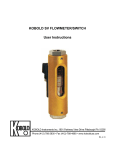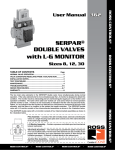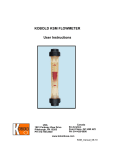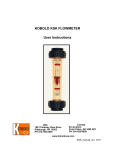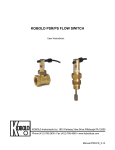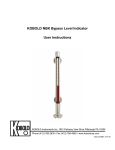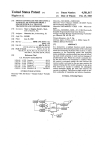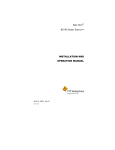Download KOBOLD SM FLOWMETER/SWITCH User Instructions
Transcript
KOBOLD SM FLOWMETER/SWITCH User Instructions KOBOLD Instruments Inc. 1801 Parkway View Drive Pittsburgh PA 15205 Phone (412) 788-2830 • Fax (412)-788-4890 • www.koboldusa.com R2_4-13 SM Table Of Contents KOBOLD SM FLOWMETER/SWITCH 1.0 General . . . . . . . . . . . . . . . . . . . . . . . . . . . . . . . . . . . . . . . . . . . . . . 1 2.0 Specifications. . . . . . . . . . . . . . . . . . . . . . . . . . . . . . . . . . . . . . . . . . . 1 3.0 Installation . . . . . . . . . . . . . . . . . . . . . . . . . . . . . . . . . . . . . . . . . . . . 2 4.0 Electrical Installation . . . . . . . . . . . . . . . . . . . . . . . . . . . . . . . . . . . . . 3 5.0 Operation . . . . . . . . . . . . . . . . . . . . . . . . . . . . . . . . . . . . . . . . . . . . . 4 5.1 Reading Flow. . . . . . . . . . . . . . . . . . . . . . . . . . . . . . . . . . . . . . . . . . . 4 5.2 Adjusting the Setpoint for Increasing Flow. . . . . . . . . . . . . . . . . . . . . 4 5.3 Adjusting the Setpoint for Decreasing Flow. . . . . . . . . . . . . . . . . . . . 4 5.4 Adjusting the Setpoint for SM Flow Switch Models w/o Indicator. . . . 5 6.0 Arrival of Damaged Equipment . . . . . . . . . . . . . . . . . . . . . . . . . . . . . 5 7.0 Maintenance . . . . . . . . . . . . . . . . . . . . . . . . . . . . . . . . . . . . . . . . . . . 5 8.0 Need help with your SM Flow Switch?. . . . . . . . . . . . . . . . . . . . . . . . 5 List Of Diagrams Diagram 4.1 Electrical Connections. . . . . . . . . . . . . . . . . . . . . . . . . . . . . . . 3 List of Tables Table 2.1 Material Composition. . . . . . . . . . . . . . . . . . . . . . . . . . . . . . . . 2 FM Rev. 4/16/13 SM KOBOLD SM FLOWMETER/SWITCH User Instructions CAUTION: 1.0 For safety reasons, please read the cautionary information located at the end of the manual, before attempting installation. General The KOBOLD SM flowmeter/switch is intended for functions involving flow triggered switching or measuring/switching of liquids and gases. The all-metal construction of the instrument makes it usable in situations where the medium is under high pressure (3600 PSIG maximum for the brass version, and 5000 PSIG maximum for the stainless steel version). The SM flow switch can be factory fitted with up to three reed switches to allow a corresponding number of setpoints to be monitored. The SM flowmeter, because of its external flow indicator, is limited to two reed switches. The principle of operation of the SM is that of the well-known float in a conical tube, or variable area flowmeter. The KOBOLD SM, however, uses our patented cylindrical control tube with V-groove to replace the conical tube. This method has advantages in that the float is stabilized over its entire measuring range and offers a large flow range in a small instrument. In the SMO, SMW and SMF versions, the action of gravity is augmented by a calibrated restoring spring to provide different measuring ranges than are possible by use of gravity alone. The float has a built-in permanent magnet that actuates a reed switch (when equipped) mounted on the exterior housing of the device. The optional switch is therefore hermetically separated from the medium. The optional switches are user adjustable so that setpoints may be adjusted to any flow value within the range of the instrument. 2.0 Specifications Measurement Accuracy: +/- 5% of Full Scale Maximum Medium Temperature: -with PP Float 240 Degrees F 160 Degrees F Maximum Operating Pressure: -with PP Float -with Brass Body/Metal Float -with SS Body/Metal Float 230 PSIG 3600 PSIG 5000 PSIG FM Rev. 4/16/13 SM 2 Switch Specifications: Maximum Voltage: Maximum Current: Maximum Power Dissipation: SPST (N/O): 50 VA/50 W SPDT:30 VA/30 W Environmental Protection: IP 65 (IEC 259) (Equal to NEMA 4) cCSAus Approval Table 2.1 Housing: Slotted Nozzle: Float: Fittings: Seals: Spring: 3.0 240 VAC SPST (N/O): 1.5 A SPDT: 0.8 A Material Composition Brass Version SS Version Ni-Plated Brass Ni-Plated Brass Ni-Plated Brass, PP, Al, 304 SS Ni-Plated Brass NBR 301 SS (SMO,SMW,SMF) 304 SS 304 SS PP, Al, 304 SS 304 SS FKM 301 SS (SMO,SMW,SMF) Installation CAUTION: For safety reasons, please read the cautionary information located at the end of the manual, before attempting installation. To install, proceed as follows: 1. The SM flowmeter/switch must be installed in the appropriate orientation as indicated for the specific model. 2. The medium must not contain any solids or contaminants that could precipitate out of solution and deposit on the instrument's inner walls. This would prevent proper operation of the device. Unclean media should be filtered upstream of the SM. KOBOLD offers a magnetic/screened filter suitable for such purposes (type MFR). 3. Do not install meter on large masses of ferritic materials, or in areas where strong electric fields are present, as this will hamper proper operation of the reed contact. FM Rev. 4/16/13 3 4.0 SM Electrical Installation Maximum values of current and voltage must not be exceeded on the reed relay. If driving inductive or capacitive loads, we recommend the use of a suitable isolation relay, KOBOLD provides a line of relays for such instances. If an isolation relay is not used, a clamping diode is highly recommended for DC inductive loads to minimize contact arcing, which will destroy the reed switch. Diagram 4.1 Electrical Connections N/O Contact (SPST) Changeover Contact (SPDT) FM Rev. 4/16/13 SM 5.0 4 Operation We recommend that if possible, a flow control valve be installed downstream of the instrument and be closed as pressure is introduced to the system. Thereafter, the control valve can be opened gradually to achieve the needed flow. This procedure prevents oscillation of the float as the medium is introduced. More importantly, it prevents possible damage due to pressure surges (as described in the cautionary section) to the SM. 5.1 Reading Flow Read the flow rate off the downstream edge of the indicator (when equipped). 5.2 Adjusting the Setpoint for Increasing Flow Adjust the setpoint for increasing flow as follows: 1. Loosen the hold-down screws on the reed contact housing. 2. Slide the contact toward the outlet along its rail until it reaches its stops. The reed contact will be deactuated at this point. 3. Open the medium feed line and set flow to desired volume. 4. Slide the reed contact toward the inlet until the contact actuates. 5. Tighten the hold-down screws. 5.3 Adjusting the Setpoint for Decreasing Flow Adjust the setpoint for decreasing flow as follows: 1. Loosen the hold-down screws on the reed contact housing. 2. Slide the contact toward the inlet along the rail until it reaches its stops. The reed contact will be actuated at this point. 3. Open the feed line and introduce flow until the reed contact deactuates, then lower the flow value to the desired minimum. FM Rev. 4/16/13 5 SM 4. Slide the contact toward the outlet until the reed contact actuates again. 5. Tighten the hold-down screws. 5.4 Adjusting the Setpoint for SM Flow Switch Models w/o Indicator Alternatively, you may adjust the approximate switching setpoint as follows: 1. Loosen the hold-down screws on the reed contact housing. 2. Slide the contact until the marking line on the switch housing aligns with the desired flow as indicated by the scale on the instrument housing. 3. Tighten the hold-down screws. Slight readjustment of the switch may be necessary to “dial in” the desired switching characteristics. 6.0 Arrival of Damaged Equipment Your instrument was inspected prior to shipment and found to be defect-free. If damage is visible on the unit, we advise that you carefully inspect the packing in which it was delivered. If damage is visible, notify your local carrier at once, since the carrier is liable for a replacement under these circumstances. If your claim is refused, please contact KOBOLD Instruments for further instructions. 7.0 Maintenance The KOBOLD SM contains few active mechanisms to wear out. Operation is achieved using a calibrated spring (SMO, SMW and SMF versions) and magnetism. This means that reliable operation and a long life may be expected from the SM. We do strongly recommend that, since dirt is the primary enemy of this instrument, only clean or filtered media be passed through it. Do not use this meter on fluids capable of corroding the 301 SS material of the spring. 8.0 Need help with your SM Flow Switch? Call one of our friendly engineers at 412-788-2830. FM Rev. 4/16/13 7 SM Caution PLEASE READ THE FOLLOWING GENERAL FLOW METER/ MONITOR WARNINGS BEFORE ATTEMPTING INSTALLATION OF YOUR NEW DEVICE. FAILURE TO HEED THE INFORMATION HEREIN MAY RESULT IN EQUIPMENT FAILURE AND POSSIBLE SUBSEQUENT PERSONAL INJURY. FM Rev. 4/16/13 SM 8 • User's Responsibility for Safety: KOBOLD manufactures a wide range of process sensors and technologies. While each of these technologies are designed to operate in a wide variety of applications, it is the user's responsibility to select a technology that is appropriate for the application, to install it properly, to perform tests of the installed system, and to maintain all components. The failure to do so could result in property damage or serious injury. • Inspect instrument for damage upon arrival: Cracked, fractured, bent or otherwise damaged instruments must not be put into use, since the device is weakened to an unknown extent. Refer to Section 6.0, Arrival of Damaged Equipment, for additional information. • Media and Chemical Compatibility: The maximum tolerances of the device have been determined using water and air. If using other media, especially corrosive media, it is critically important that the user determine chemical compatibility with our instruments. KOBOLD Instruments Inc. cannot accept responsibility for failure and consequences resulting from use of media other than water, air, and nitrogen. • Material Compatibility: Make sure that the model which you have selected is chemically compatible with the application liquids. While the meter is liquid and spray resistant when installed properly, it is not designed to be immersed. • Proper Installation in Flow System: Install the device in a fully supported position within your flow system. This avoids excessive stresses which may damage the instrument. In particular: a.) Ensure that the plumbing leading to and from the instrument is fully supported and that the instrument does not perform the physical function of a joint. b.) When calculating stress on the device caused by plumbing, the weight of the medium in the pipes must be considered as well. c.) Misaligned runs of rigid piping can cause large stresses when connected to the instrument. Do not connect in such a fashion. d.) When connecting fittings, hold the instrument fittings rigid with a correctly sized wrench. Do not install by twisting the instrument into the pipe fittings. e.) Do NOT install by holding the device housing to provide counter-torque to the pipe fitting. f.) Use an appropriate amount of PTFE tape on male threads of fitting. This reduces the twisting stresses produced by tightening the fittings into each other. g.) Do not use pliers or wrenches on the housing, as this may damage it. h.) Do not overtighten, as this may fracture the fittings. FM Rev. 4/16/13 9 • SM While Operating the Flow System: During operation, there are a number of situations to avoid: a.) The sudden cessation of fluid flow causes what is typically referred to as "water hammer". Most people are familiar with this phenomenon from their home experience - it is the cause behind the loud clank of water pipes which occurs when faucets are turned off too suddenly. The cause behind this "water hammer" is quite easy to visualize. Water is fairly massive. The amount of water in long runs of pipe is quite substantial. When the faucets are turned off suddenly, especially from a full on condition, the water has considerable momentum and does not want to stop flowing. The situation is similar to stopping a car by running into a wall, rather than by applying brakes. Both are sudden rather than gradual. The damage to the wall can be substantial (not to mention the car). b.) The "water hammer" causes surges in fluid pressure which could cause the measurement instrument's pressure limit to be exceeded, resulting in failure and possible personal injury. c.) Fluid surges, as well as the water hammer, can be particularly damaging to empty flowmeters since there is no back pressure in the device. The damage is caused, once again, by momentary excess pressure. To avoid these surges, fluid lines should remain full (if possible) and water flow should be introduced to the device slowly. d.) If the instrument is isolated with inlet and outlet valves, the flowmeter must be completely drained when said valves are both closed. Failure to do so could result in damage to the device caused by thermal expansion of fluid. e.) Freezing of water in the instrument must be avoided since the resultant expansion will damage the flowmeter and make it unsafe for use. • Wiring and Electrical: Section 2.0, Specifications and Section 4.0, Electrical Connections, provide the voltage and current limitations and the wiring for the various sensor types. The sensor electrical ratings should never be exceeded. Electrical wiring of the sensor should be performed in accordance with all applicable national, state and local codes. • Temperature and Pressure: Section 2.0, Specifications, provides the temperature and pressure limits for each model. Operation outside these limitations will cause damage to the unit and can potentially cause personal injury. Fluid should never be allowed to freeze inside the sensor. • Make a Fail-safe System: Design a fail-safe system that accommodates the possibility of switch or power failure. In critical applications, KOBOLD recommends the use of redundant backup systems and alarms in addition to the primary system. FM Rev. 4/16/13













